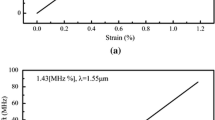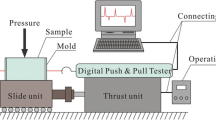Abstract
Deformation and failure of overlying strata caused by underground mining can result in the leakage of overburden aquifers, seriously threatening underground safety and the surface environment. However, conventional methods such as simulation and theoretical calculation cannot comprehensively reflect the dynamic movement of the overburden during mining. This study, therefore, applied two distributed optical fiber sensing (DOFS) technologies, Brillouin optical time-domain reflectometry (BOTDR) and fiber Bragg grating (FBG) sensing technologies, to quantitatively monitor overburden movement in real time. Results indicate that tensile failure dominated in the overburden during mining, and strain accumulation generated mostly at the lithologic interfaces and loess interior. The displacements of bedrock and loess layers reached their maximum values of 76.65 mm and 59.61 mm, respectively, when the excavation face had passed the sensing borehole by 83.16 m. The water-flowing fractured zone (WFFZ) penetrated the bedrock layer and 4.35 m into the loess layer, and it reached the maximum height 225.43 m when the excavation face had passed the sensing borehole by 94.36 m. The fracture angle of roof rock strata was 67.29°. Compared with the microresistivity scanning technology and numerical simulation, the DOFS technologies could more accurately determine the maximum height of the WFFZ. The results are of engineering significance for underground safe mining and surface environmental protection.





















Similar content being viewed by others
References
Bai E, Guo W, Tan Y (2019) Negative externalities of high-intensity mining and disaster prevention technology in China. Bull Eng Geol Environ 78:5219–5235. https://doi.org/10.1007/s10064-019-01468-4
Bernini R, Minardo A, Zeni L (2008) Vectorial dislocation monitoring of pipelines by use of Brillouin-based fiber-optics sensors. Smart Mater Struct 17:015006. https://doi.org/10.1088/0964-1726/17/01/015006
Bise CJ (2013) Modern American coal mining: methods and applications. Society for Mining, Metallurgy, and Exploration
Cai Z, Li C, Guan Y et al (2013) FBG earth pressure sensors applied in surrounding rock pressure of tunnel. Appl Mech Mater 351–352:1173–1178
Cheng G, Shi B, Zhu H et al (2015) A field study on distributed fiber optic deformation monitoring of overlying strata during coal mining. J Civil Struct Health Monit 5:553–562. https://doi.org/10.1007/s13349-015-0135-6
Chi Y, Bai Q, Wang Y et al (2018) Distributed optical fiber system for pipeline strain hazard inspection using BOTDR. Chin J Sens Actuat 31:1775–1780. https://doi.org/10.3969/j.issn.1004-1699.2018.011.027(inChinese)
Cui W, Wang B, Wang Y (2020) High-precision inversion method of coal seam thickness based on transmission channel wave. J China Coal Soc 45:2482–2490. https://doi.org/10.13225/j.cnki.jccs.DZ20.0670(inChinese)
Duan Z, Peng J (2015) Experimental Study of Triaxial Creep Characteristics of Q2 Loess in Yan’an[C]//2015 2nd International Workshop on Materials Engineering and Computer Sciences. Atlantis Press
Espada M, Muralha J, Lemos JV et al (2018) Safety analysis of the left bank excavation slopes of Baihetan arch dam foundation using a discrete element model. Rock Mech Rock Eng 51:2597–2615. https://doi.org/10.1007/s00603-018-1416-2
Hamdan H, Nikos A, George K et al (2014) Contribution of electrical tomography methods in geotechnical investigations at Mavropigi lignite open pit mine, Northern Greece. Environ Earth Sci 72:1589–1598. https://doi.org/10.1007/s12665-014-3063-6
Han J, Zhang H, Gao Z et al (2016) Failure height of weak overburden by layered fully-mechanized mining in extremely thick coal seam. J Min Saf Eng 33:226–230. https://doi.org/10.13545/j.cnki.jmse.2016.02.006(inChinese)
Handawi AK, Vahdati N, Rostron P et al (2016) Strain based FBG sensor for real-time corrosion rate monitoring in pre-stressed structures. Sensor Actuat B: Chem 236:276–285. https://doi.org/10.1016/j.snb.2016.05.167
Hong CY, Zhang YF, Li GW et al (2017) Recent progress of using Brillouin distributed fiber sensors for geotechnical health monitoring. Sensor Actuat A: Phys 258:131–145. https://doi.org/10.1016/j.sna.2017.03.017
Huang A, Wang C, Lee J et al (2016) Applications of FBG-based sensors to ground stability monitoring. J Rock Mech Geotech Eng 8:513–520. https://doi.org/10.1016/j.jrmge.2016.01.007
International Society for Rock Mechanics (2007) The complete ISRM suggested methods for rock characterization, testing and monitoring: 1974–2006. International Society for Rock Mechanics, Commission on Testing Methods
Jiránková E, Petroš V, Šancer J (2012) The assessment of stress in an exploited rock mass based on the disturbance of the rigid overlying strata. Int J Rock Mech Min Sci 50:77–82. https://doi.org/10.1016/j.ijrmms.2012.01.004
Ju J, Xu J (2015) Surface stepped subsidence related to top-coal caving longwall mining of extremely thick coal seam under shallow cover. Int J Rock Mech Min Sci 78:27–35. https://doi.org/10.1016/j.ijrmms.2015.05.003
Ju M, Li X, Yao Q et al (2017) Effect of sand grain size on simulated mining-induced overburden failure in physical model tests. Eng Geol 226:93–106. https://doi.org/10.1016/j.enggeo.2017.05.015
Kersey AD, Davis MA, Patrick HJ et al (1997) Fiber grating sensors. J Lightwave Technol 15:1442–1463. https://doi.org/10.1109/50.618377
Klar A, Linker R (2010) Feasibility study of automated detection of tunnel excavation by Brillouin optical time domain reflectometry. Tunn Undergr Space Technol 25:575–586. https://doi.org/10.1016/j.tust.2010.04.003
Klar A, Bennett P, Soga K et al (2006) Distributed strain measurement for pile foundations. ICE Proc Geotech Eng 159:135–144. https://doi.org/10.1680/geng.2006.159.3.135
Klar A, Dromy I, Linker R (2014) Monitoring tunneling induced ground displacements using distributed fiber-optic sensing. Tunn Undergr Space Technol 40:141–150. https://doi.org/10.1016/j.tust.2013.09.011
Li Y, Wang H, Zhu W et al (2015) Structural stability monitoring of a physical model test on an underground cavern group during deep excavations using FBG sensors. Sensors 15:21696–21709. https://doi.org/10.3390/s150921696
Lin ML, Chung CF, Jeng FS et al (2007) The deformation of overburden soil induced by thrust faulting and its impact on underground tunnels. Eng Geol 92:110–132. https://doi.org/10.1016/j.enggeo.2007.03.008
Liu Y, Li W, He J et al (2018) Application of Brillouin optical time domain reflectometry to dynamic monitoring of overburden deformation and failure caused by underground mining. Int J Rock Mech Min Sci 106:133–143. https://doi.org/10.1016/j.ijrmms.2018.04.030
Liu S, Li W, Qiao W et al (2019) Effect of natural conditions and mining activities on vegetation variations in arid and semiarid mining regions. Ecol Indic 103:331–345. https://doi.org/10.1016/j.ecolind.2019.04.034
Lu Q, Peng J (2006) Research on systematic frame and some problems of engineering geology of loess mass. J Jilin Univ (earth Sci Edit) 36:404–409
Lu Y, Shi B, Wei GQ et al (2012) Application of a distributed optical fiber sensing technique in monitoring the stress of precast piles. Smart Mater Struct 21:115011. https://doi.org/10.1088/0964-1726/21/11/115011
Ma L, Jin Z, Liang J et al (2015) Simulation of water resource loss in short-distance coal seams disturbed by repeated mining. Environ Earth Sci 74:5653–5662. https://doi.org/10.1007/s12665-015-4581-6
Manandhar S, Miyazoe K, Fukuoka S et al (2016) Observation of static load of L-shaped retaining wall constructed on short wooden pile using fiber optic geogrid BOTDR method. Indian Geotech J 46:398–407. https://doi.org/10.1007/s40098-016-0182-x
Meng Z, Shi X, Li G (2016) Deformation, failure and permeability of coal-bearing strata during longwall mining. Eng Geol 208:69–80. https://doi.org/10.1016/j.enggeo.2016.04.029
Miao X, Cui X, Wang J et al (2011) The height of fractured water-conducting zone in undermined rock strata. Eng Geol 120:32–39. https://doi.org/10.1016/j.enggeo.2011.03.009
Mohamad H, Soga K, Bennett P et al (2012) Monitoring twin tunnel interaction using distributed optical fiber strain measurements. J Geotech Geoenviron Eng 138:957–967. https://doi.org/10.1061/(ASCE)GT.1943-5606.0000656
Munoz H, Taheri A, Chanda EK (2016) Fracture energy-based brittleness index development and brittleness quantification by pre-peak strength parameters in rock uniaxial compression. Rock Mech Rock Eng 49:4587–4606
Pei HF, Yang Q, Li ZJ (2016) Early-age performance investigations of magnesium phosphate cement by using fiber Bragg grating. Constr Build Mater 120:147–149. https://doi.org/10.1016/j.conbuildmat.2016.05.089
Peng S (2008) Coal Mine Ground Control. West Virginia University, Morgantown
Piao CD, Shi B, Gao L (2011) Characteristics and application of BOTDR in distributed detection of pile foundation. Adv Mater Res 163–167:2657–2665
Shi B, Xu H, Chen B et al (2003) A feasibility study on the application of fiber-optic distributed sensors for strain measurement in the Taiwan Strait Tunnel project. Mar Georesour Geotec 21:333–343. https://doi.org/10.1080/713773406
Shi L, Hong C, Wei X et al (2019) Development and verification of new geotechnical engineering FBG inclination sensor. Chin J Sens Actuat 32:485–490. https://doi.org/10.3969/j.issn.1004-1699.2019.04.002(inChinese)
Soga K (2014) Understanding the real performance of geotechnical structures using an innovative fibre optic distributed strain measurement technology. Riv Ital Geotech 4:7–48
Sui W, Hang Y, Ma L et al (2015) Interactions of overburden failure zones due to multiple-seam mining using longwall caving. Bull Eng Geol Environ 74:1019–1035
Sun J, Wang LG, Hou HQ (2012) Application of micro-seismic monitoring technology in mining engineering. Int J Min Sci Technol 22:79–83. https://doi.org/10.1016/j.ijmst.2011.06.007
Wang B, Li K, Shi B et al (2009) Test on application of distributed fiber optic sensing technique into soil slope monitoring. Landslides 6:61–68
Wang G, Wu M, Wang R et al (2017) Height of the mining-induced fractured zone above a coal face. Eng Geol 216:140–152. https://doi.org/10.1016/j.enggeo.2016.11.024
Wang Z, Li W, Wang Q et al (2019) Relationships between the petrographic, physical and mechanical characteristics of sedimentary rocks in Jurassic weakly cemented strata. Environ Earth Sci 78:131
Wei J, Wu F, Yin H et al (2017) Formation and height of the interconnected fractures zone after extraction of thick coal seams with weak overburden in Western China. Mine Water Environ 36:59–66
Wu Z, Xu B, Takatada T et al (2008) Performance of a BOTDR optical fiber sensing technique for crack detection in concrete structures. Struct Infrastruct Eng 4:311–323. https://doi.org/10.1080/15732470600899346
Xing Y, Kulatilake PHSW, Sandbak LA (2018) Effect of rock mass and discontinuity mechanical properties and delayed rock supporting on tunnel stability in an underground mine. Eng Geol 238:62–75. https://doi.org/10.1016/j.enggeo.2018.03.010
Xu D, Tong F, Pei H et al (2013) In-situ monitoring of internal displacements by FBG sensors and slope stability analysis under rainfall infiltration. Geotech Eng 44:68–74
Yu B, Zhao J, Xiao H (2017) Case study on overburden fracturing during longwall top coal caving using microseismic monitoring. Rock Mech Rock Eng 50:507–511
Zeni L, Picarelli L, Avolio B et al (2015) Brillouin optical time-domain analysis for geotechnical monitoring. J Rock Mech Geotech Eng 7:458–462. https://doi.org/10.1016/j.jrmge.2015.01.008
Zhang D, Zhang P, Shi B et al (2015) Monitoring and analysis of overburden deformation and failure using distributed fiber optic sensing. Chin J Geotech Eng 37:952–957. https://doi.org/10.11779/CJGE201505023
Zhang D, Wang J, Zhang P et al (2017) Internal strain monitoring for coal mining similarity model based on distributed fiber optical sensing. Measurement 97:234–241. https://doi.org/10.1016/j.measurement.2016.11.017
Zhu HH, Yin JH, Zhang L et al (2010) Monitoring internal displacements of a model dam using FBG sensing bars. Adv Struct Eng 13:249–261. https://doi.org/10.1260/1369-4332.13.2.249
Zhu HH, Shi B, Zhang J et al (2014) Distributed fiber optic monitoring and stability analysis of a model slope under surcharge loading. J Mt Sci 11:979–989
Zhu HH, Shi B, Yan JF et al (2015) Investigation of the evolutionary process of a reinforced model slope using a fiber-optic monitoring network. Eng Geol 186:34–43. https://doi.org/10.1016/j.enggeo.2014.10.012
Acknowledgements
This work is financially supported by the State Key Program of the National Natural Science Foundation of China (Grant No. 41430643) and the National Program on Key Basic Research Project (Grant No. 2015CB251601).
Author information
Authors and Affiliations
Corresponding author
Ethics declarations
Conflict of interest
The authors declare that they have no conflict of interest.
Additional information
Publisher's Note
Springer Nature remains neutral with regard to jurisdictional claims in published maps and institutional affiliations.
Rights and permissions
About this article
Cite this article
Wang, Z., Li, W., Wang, Q. et al. Monitoring the Dynamic Response of the Overlying Rock–Soil Composite Structure to Underground Mining Using BOTDR and FBG Sensing Technologies. Rock Mech Rock Eng 54, 5095–5116 (2021). https://doi.org/10.1007/s00603-021-02530-y
Received:
Accepted:
Published:
Issue Date:
DOI: https://doi.org/10.1007/s00603-021-02530-y




